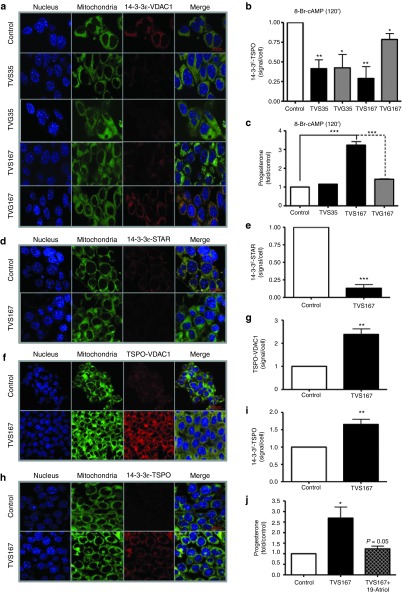Figure 3.
Blocking the interaction between 14-3-3ɛ and voltage-dependent anion channel (VDAC1) negates the regulatory role of 14-3-3ɛ in steroidogenesis. (a,b) The Duolink assay was performed to measure protein–protein interactions between 14-3-3ɛ and endogenous VDAC1 in untreated MA-10 cells (control) or cells treated with the TVS35, TVG35, TVS167, or TVS167 peptides, after 8-Br-cAMP (120 minutes) treatment, which induces maximum 14-3-3ɛ-VDAC1 interaction (red). Staining of nucleus (blue) and mitochondrial (green) are also shown. (c) Progesterone levels in control MA-10 cells or cells treated with TVS35, TVS167, or TVS167 were measured after 8-Br-cAMP (120 minutes) treatment. Levels of progesterone were normalized to protein content and further compared to the levels in control cells, as fold increase. (d–g,i,j) The impact of blocking interactions between 14-3-3ɛ-VDAC1 on other transduceosome protein–protein interactions was studied in the presence of TVS167. MA-10 cells were treated with TVS167 and 8-Br-cAMP (120 minutes). The interactions between 14-3-3ɛ-STAR (d,e), TSPO-VDAC1 (f,g), and 14-3-3ɛ-TSPO (h,i) were measured, as endogenous protein–protein interactions. Histograms show the sum of protein–protein interactions in Z-stacks as signal/cell ratio. (j) The physiological impact of the increase in 14-3-3ɛ-TSPO interactions on cholesterol binding to TSPO was studied. Progesterone levels in control (untreated), TVS167-treated, and combination 19-Atriol/TVS167-treated MA-10 cells were measured after 8-Br-cAMP stimulation (120 minutes).

